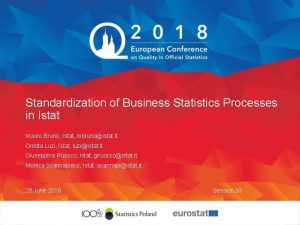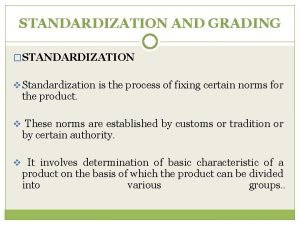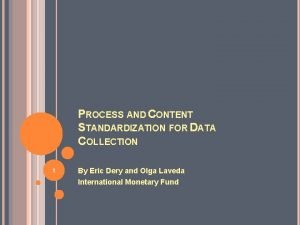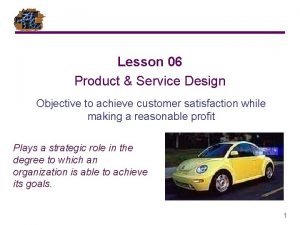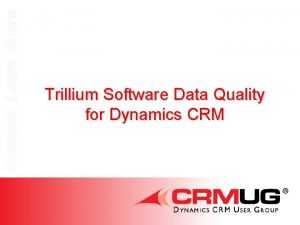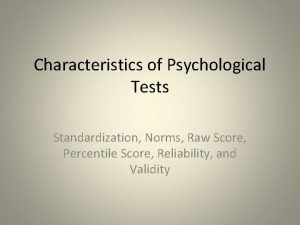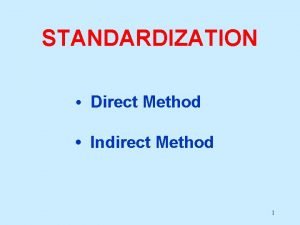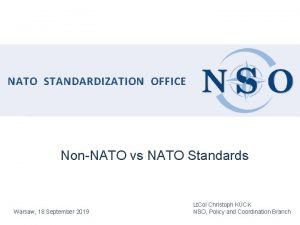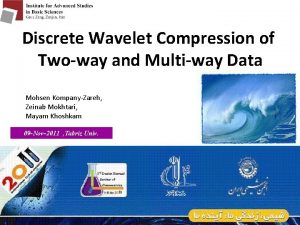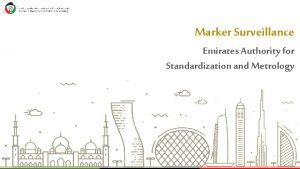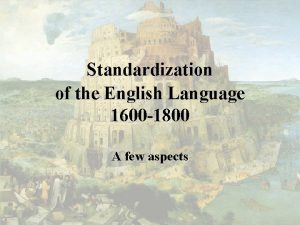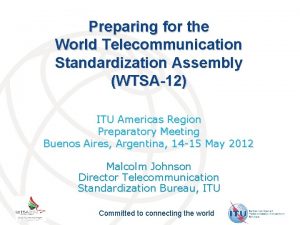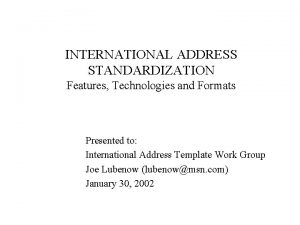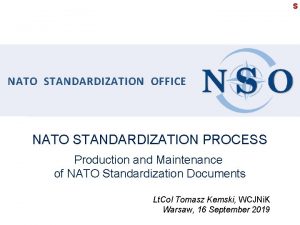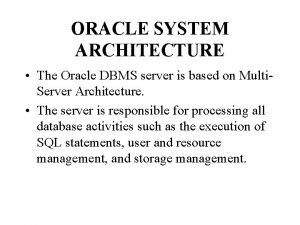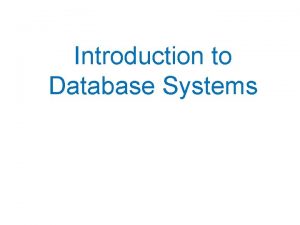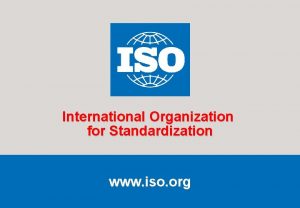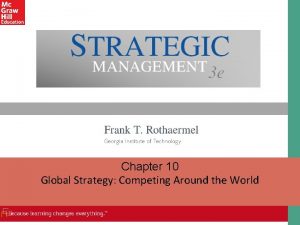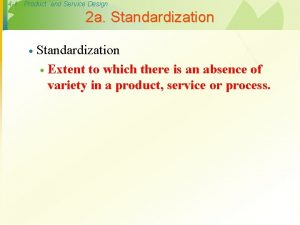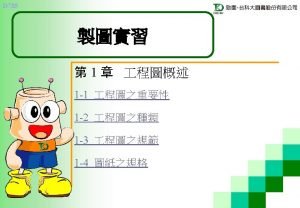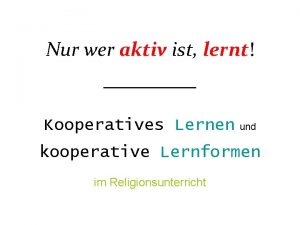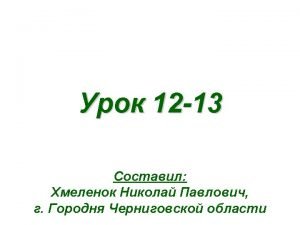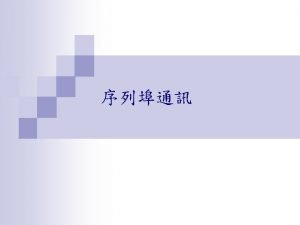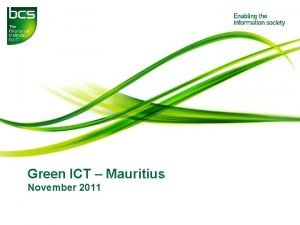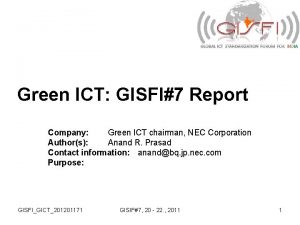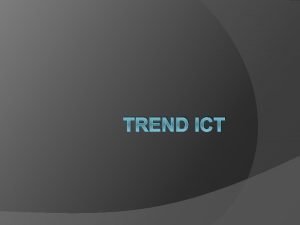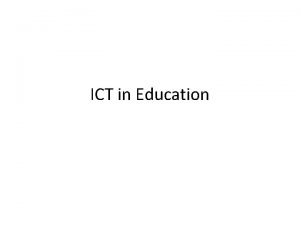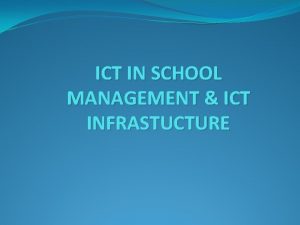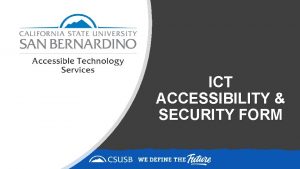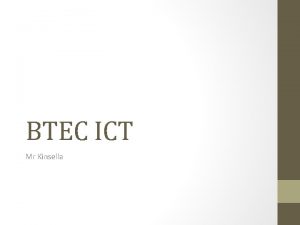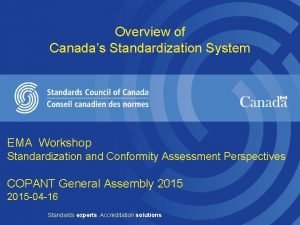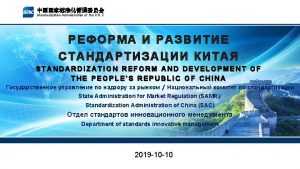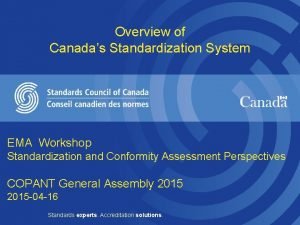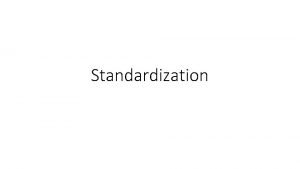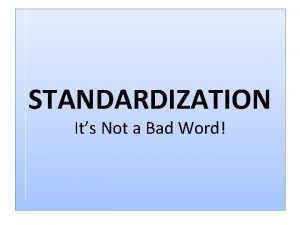Standardization of Green ICT with Green Communication Professor







































- Slides: 39

Standardization of Green ICT with Green Communication Professor G. N. Pandey Indian Institute of Information Technology Allahabad

INDEX • Introduction • Brief • Details • Benefits • Conclusion

INTRODUCTION • From both an individual and organizational perspective the global environmental issues we all face are here to stay for the foreseeable future. • Arguably the most commonly known and widely reported environmental concern nowadays is global climate change/global warming. For many of us in the Information Communication & Technology (ICT) Industry, the environmental spotlight is shining directly at us, as the consumption of energy derived from traditional fossil fuels becomes an international concern. • It is widely cited in Information Technology (IT) circles that the ICT industry is responsible for approximately two per cent of world-wide carbon emissions, which is roughly the equivalent to the carbon emissions attributed to the aviation industry

Present Statistics • Power Consumption in ICT=2% • 54 of the total import is Petroleum causing environmental degradation and foreign exchange drain • Obsolesce in ICT - E-Waste

What is Green ICT • The study and practice of designing, manufacturing, using, and disposing of computers, servers, and associated subsystems—such as monitors, printers, storage devices, and networking and communications systems—efficiently and effectively with minimal or no impact on the environment. • In the article Harnessing Green IT: Principles and Practices, San Murugesan defines the field of green computing as “The study and practice of designing, manufacturing, using, and disposing of computers, servers, and associated subsystems—such as monitors, printers, storage devices, and networking and communications systems—efficiently and effectively with minimal or no impact on the environment.

Necessity of Green ICT "Green ICT" fall into one of two broad categories. • Those intended to deal with global warming by either reducing greenhouse gas emissions or in the alternative its potential harmful effects on the planet. • Those technologies associated with establishing economic "sustainable growth" which includes recycling, resource reduction and many aspects of the biosciences

Necessity of Green ICT

Lack of Classical Energy It is well established that • Tropical countries with • poor connectivity, • poor availability of energy • poor quality of electricity. • And Greater availability of Green Resources • Solar energy • Wind energy • Geothermal energy • Bio mass • & poor standardization

Distribution of Classical Energy

Energy Distribution over the Globe

Solar Energy Distribution over the Globe

Solar Energy Distribution w. r. t population


Wind Energy Distribution over India

Solar Energy Distribution over India

Due to Impacting Environment • Emissions to air • Releases to water • Releases to land • Use of toxic materials in equipment • Use of resources to produce Energy • Energy emitted from use of Products • Waste and by-products …. etc

Resource of Green Technology • Green technologies will help • Solar, wind, tide, geothermal, bio move the declining use of fossil gas etc. (LOCATION SPECIFIC) fuels. • Sustainable in the long term. • Better for the environment al • Produce new jobs. protection.

Why a Green ICT? The Opportunity: • ICT may achieve up to 90% of Kyoto targets (ITU, 2008); • ICT has potential to decrease overall GHG by 15% and save global; industry $US 800 billion in annual energy costs by 2020; • Carbon economy growing by 58% to $92 B, $500 B by 2050. Is Cost Savings or the Environmental Issue the Real Driver? � Many enterprises are motivated primarily by cost savings � Some are concerned about controlling environmental pollution.

How are Green ICT used today? "Green ICT" fall into one of two broad categories. • Those intended to deal with global warming by either reducing greenhouse gas emissions or in the alternative its potential harmful effects on the planet. • Those technologies associated with establishing economic "sustainable growth" which includes recycling, resource reduction and many aspects of the biosciences

Green ICT Deliverables As next step, working on: ü Paper less Office ü Energy Audit ü Reduce In plain language, Green ICT is working out means of how IT can help ‘Save our Planet’ from environmental issues. Green ICT • Is not a product • It is not a one time effort

Common Standards of Green ICT IEEE P 1680 Family of Standards for Environmental Assessment of Electronic Products IEEE P 1680. 1 Electronic Product Environmental Assessment Tool(EPEAT) standards. The Green Grid: 1. A global consortium dedicated to advancing energy efficiency in data centers and business computing ecosystems. 2. It was founded in February 2007 3. Founded by several key companies in the industry – AMD APC, Dell, HP, IBM, Intel, Microsoft, Rackable Systems, Spray. Cool, Sun Microsystems and Vmware Green 500: * It rates supercomputers by energy efficiency (megaflops/watt), encouraging a focus on efficiency rather than absolute performance

As Photovoltaic Mobile and Laptop Recharger

Technology • It works on principle of solar energy is converted into electrical energy • Photovoltaic solar panels are composed mainly of silicon. Silicon is used because it naturally releases electrons (electrical energy) when hit with a photon (light source). • photovoltaic solar panel consist of a clear protective top layer, two layers of specially treated silicon with collecting circuitry attached to the top layer , and a tough polymer backing layer. • These two layers are separated by an electrically charged junction, which allows electrons to flow from back to front • When light strikes the PV panel, some of the photons are absorbed by the silicon layers. The photons cause electrons to be released from the silicon crystal.

Tools • • • Solar Panel Solar Regulator DC – battery storage Inverter (DC to AC Conversion) Mobile/Laptop

Process

Benefit from the project for Mobile Energy saves: - In India, there are 750 million mobile users and in general, every mobile Charges for at least 20 minutes and each mobile charger stores on an average 4. 4 W-H or 15840 Joule or 15. 8 k. J. It means an energy= 4. 4*750, 000=3, 300, 000=3. 3 GW-H which mean on an average, daily 3. 3 GW-H is Daily consumed for this purpose only and this all can be reduced by using our solar charger. All This energy Generally comes from conventional Sources which contributes to Environmental pollution. So, total power consumption in a whole year 3. 3*365=1204. 5 GW-H CO 2 Emission controlled: - 7557 Giga gram CO 2 extracting stopped per day. And it Reduced 29. 63% CO 2 emission per year. Help to reduce the responsibility of the CO 2 from the Global warming effect: - 49. 08% per year. Help to decrease the warming temperature of the atmosphere: - 49. 06% per year. More facilitated: - Any where the mobile can be recharged by solar power.

Benefit from the project for Laptop Energy saves: - In India, there are 2. 5 million laptop users and in general, every laptop consumes all total average 80 W-H in 1 hour. It means the amount of total power consumed while working with the laptop at least 8 hours in a day, E = 80*8*2500000 = 1, 600, 000 W-H which mean on an average, daily 1. 6 Giga W-H energy is Daily consumed for this purpose only and in one year the total power consumption in India only, X = 1. 6 * 365 = 584 Giga W-H. CO 2 Emission controlled: - 0. 1 ton extracting from one laptop in each year. So, the total Carbon Dioxide emission from India only, S = 0. 1 * 2, 500, 000 = 250, 000 ton or 250 Kilo Ton carbon dioxide emitted from India only. Cost: - the cost of the solar panel is about 600. But when the charger will be manufactured at the industrial level the pries decrease below 500.

Benefit from Computer peripherals Power consumption percentage

Benefit from Computer peripherals • The average desktop computer consumes = 407 k. Wh per year. • The average CRT monitor consumes approximately = 220 k. Wh per year, and the average LCD monitor consumes =132 k. Wh per year. • The average laser printer in the study consumed = 280 k. Wh per year. • Laser multifunction devices followed suit, consuming = 200 k. Wh per year on average. Total no. of personal computer in India is 15 million. So, the total amount of power consumption by the computers in India is = 15, 000*407= 6, 105, 000 k. Wh or 6105 Giga WH. A complete desktop PC emanates 0. 7 kg carbon dioxide per k. Wh. So, the total amount of carbon dioxide emission is 0. 7* 6, 105, 000= 4, 273, 500, 000 kg or 4. 27 million ton of carbon dioxide.

Base Transmitting Station (BTS)

Benefit from the project for BTS Energy saves: - In India, there are over 3, 30, 000 Base Transmitting Station (BTS) and every BTS consumes all total average 5 k. W-H in 1 hour including all payloads. So, the total power consumed in a day by BTS, P= 5*24 = 120 k. W-H, and in one year the power consumption is, E = 120 * 365 = 43, 800 k. W-H and for all BTS in India the value becomes, Q = 43800 * 330000 = 14454, 000 k. W-H which mean on an average the total power consumption in one year in India only by all BTSs is = 14. 454 Tera W-H = 14454 Giga W-H. Fuel controlled: - In India, there are over 1, 12, 000 Base Transmitting Station (BTS) in rural areas only and due to the power supply problem the 15 k. W-H Diesel Generator consumes 2 liter diesel per hour. So, the total consumption by the BTSs in rural area in one hour H= 2 * 3, 30, 000 = 6, 60, 000 liter diesel. They averagely run 12 hours in a day. So, the total fuel consumption in a day by all BTSs C = 660000 * 12 = 7, 290, 000 liter diesel. So, in one year the total fuel consumption is F = 7920000 * 365 = 2, 890, 800, 000 liter or more than 2. 890 million ton of diesel. CO 2 Emission controlled: - each liter diesel burning produces 2. 68 kg Carbon dioxide. So, the total amount of carbon dioxide is produced from the BTSs’ diesel generators from India only X = 2, 890, 800, 000 * 2. 68 = 7, 747, 344, 000 kg of carbon dioxide or 7. 747344 million ton of carbon dioxide from India only.

Benefit from ICT industries

Total amount of savings from ICT 14454 Giga Watt hours from BTS 6105 Giga Watt hours from computer & its peripherals 584 Giga Watt hours from laptops 1204 Giga Watt hours from mobile ----------------------------------(Total) 22, 347 Giga Watt hours can be saved per year only from India ---------------------------------- 7. 75 million ton from BTS 4. 27 million ton from computer & its peripherals 0. 35 million ton from laptops ----------------------------------(Total) 12. 37 million ton of carbon dioxide per year only from India ---------------------------------- If it would be stopped it helps to reduced 29. 63% CO 2 emission per year. Help to reduce the responsibility of the CO 2 from the Global warming effect: - 49. 08% per year. Help to decrease the warming temperature of the atmosphere: - 49. 06% per year.

The Future of Green ICT Government’s starting renewable energy plans for their nations. Government’s starting environmental procedures to help the environment out. Human’s are becoming aware of the affects they take on this planet and acting. The Private Sector is investing in green technologies to save money. The future of green technology is now!

Special Interest • Solar charger for computer and computer peripherals for rural area where electricity is available for 4 hours with poor quality of electric supply with frequent interruptions and voltage fluctuation. • For Rural exchange and Telephone service due to the irregularities of supply of current and voltage fluctuation. • should be appreciated that energy consumption is in the following order: – agriculture -minimum – Service sector – Manufacturing-maximum For the same turn over.

Conclusion It is quite possible to introduce photovoltaic /wind energy system for mobile, computer and computer peripherals as well as rural exchanges. Mobile charger is already in place. Within next 3 months photovoltaic/wind energy system will be in place for computerdesktop, laptop, computer peripherals as well as rural telephone exchanges for demonstration purposes.

Industry-Academic partnership IIIT-A ready for the challenge

Acknowledgement • Sonali Agarwal, senior lecturer • Sayantan Nath, research scholar • Vishwajit Gautam

Thank you
 Promotion from associate professor to professor
Promotion from associate professor to professor Red green show
Red green show Professor green lecture 1
Professor green lecture 1 Standardization statistics
Standardization statistics Difference between standardization and grading
Difference between standardization and grading Data standardization process
Data standardization process Milk standardization formula
Milk standardization formula Kmno4 uses
Kmno4 uses Standardization of outputs
Standardization of outputs Standardized product design
Standardized product design Standardization in dbms
Standardization in dbms Trillium data quality
Trillium data quality What is raw score in psychology
What is raw score in psychology Standardization of outputs
Standardization of outputs Satori address
Satori address Test construction and standardization
Test construction and standardization What is recipe standardization
What is recipe standardization Direct and indirect standardization
Direct and indirect standardization 5 phase
5 phase Direct standardization example
Direct standardization example Emirates authority for standardization and metrology logo
Emirates authority for standardization and metrology logo Maximo for oil and gas
Maximo for oil and gas Step 7 training
Step 7 training Standard recipe costing
Standard recipe costing How to pronounce standardization
How to pronounce standardization World telecommunication standardization assembly
World telecommunication standardization assembly International address formats
International address formats Nato standardization office
Nato standardization office Dbms system architecture
Dbms system architecture Dbms standardization
Dbms standardization Iso/casco
Iso/casco Global standardization strategy
Global standardization strategy Standardization in product and service design
Standardization in product and service design International organization for standardization
International organization for standardization Lernpyramide von green & green (2005)
Lernpyramide von green & green (2005) Red green yellow blue
Red green yellow blue Frc control system
Frc control system Parallel vs serial communication
Parallel vs serial communication What is oral communication and written communication
What is oral communication and written communication Parallel serial communication
Parallel serial communication



